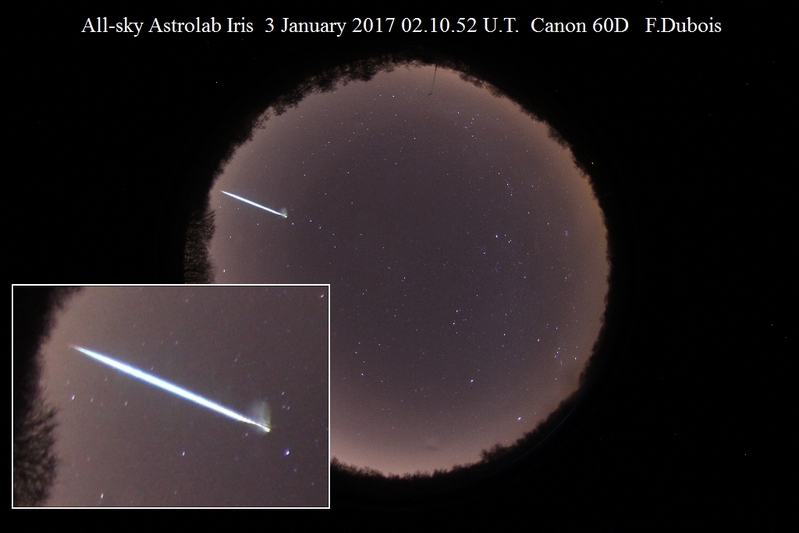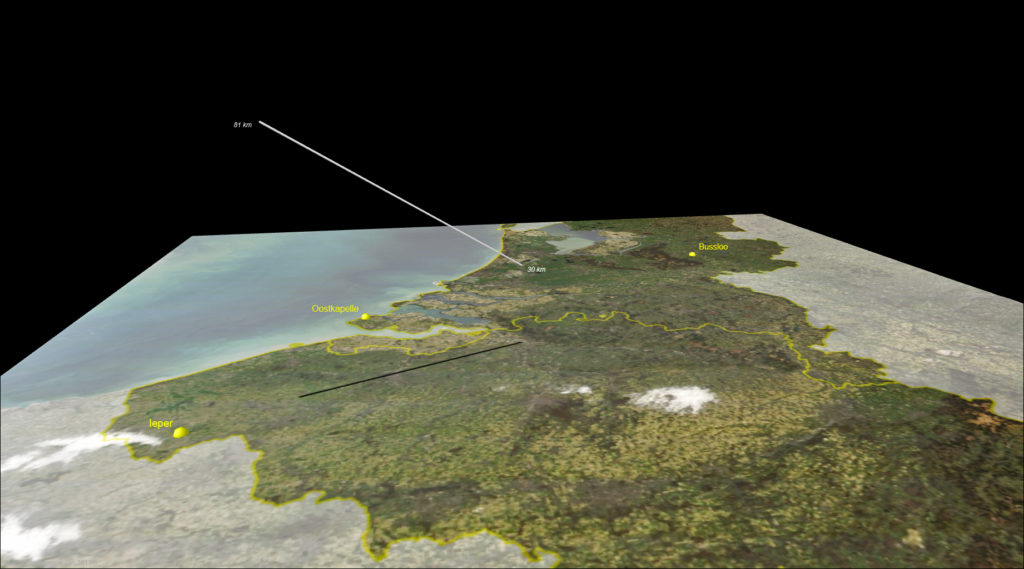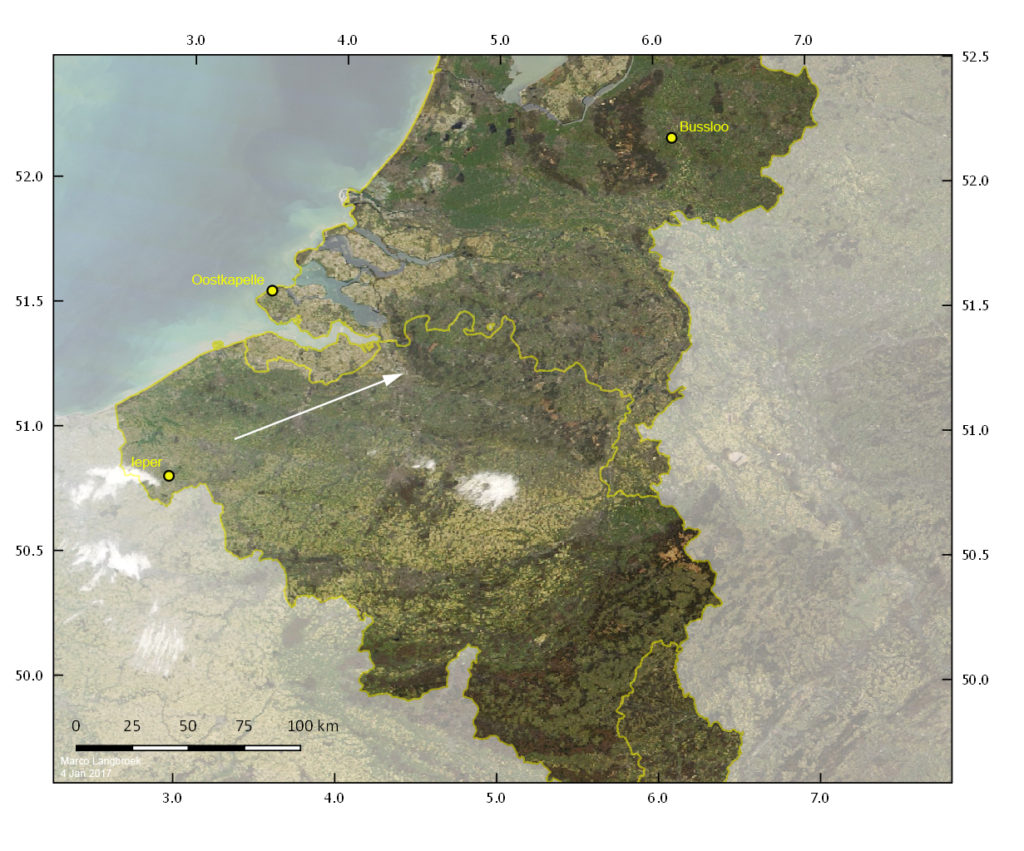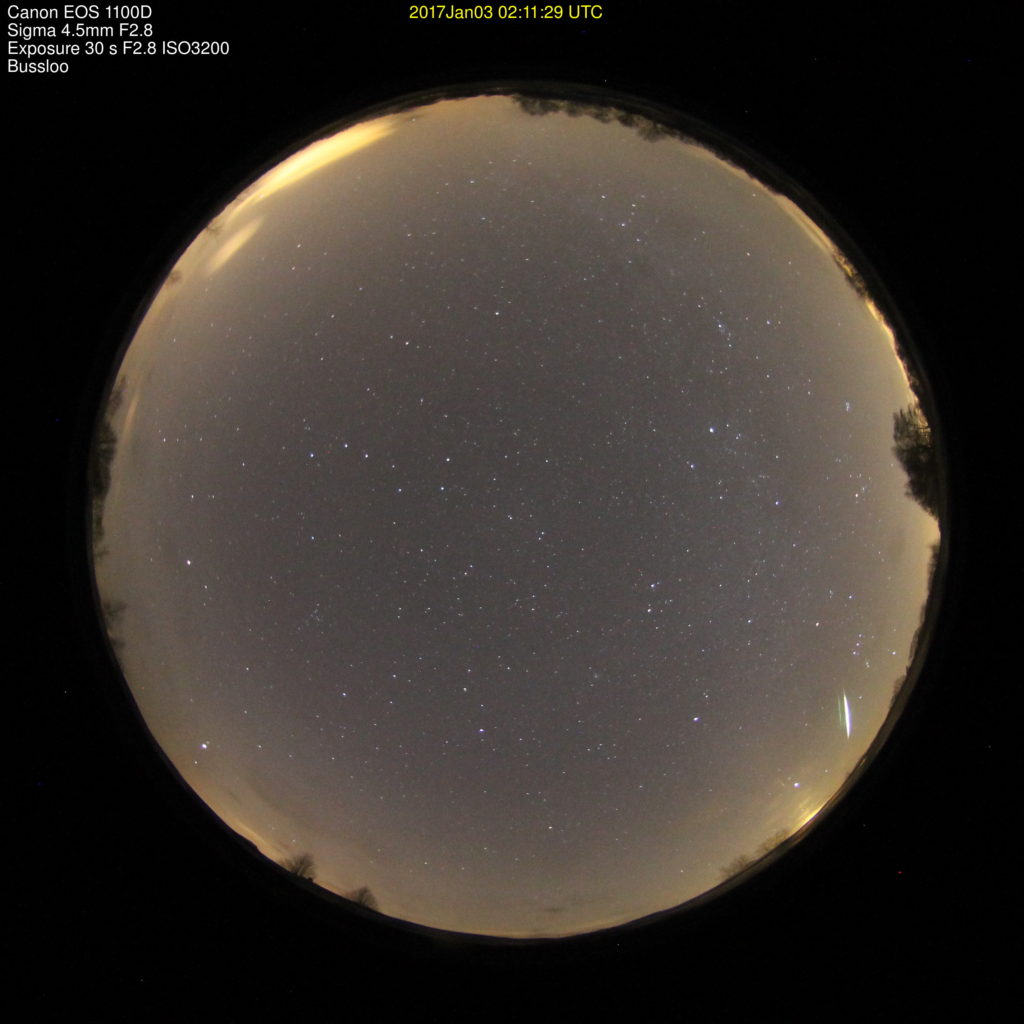The night of 2-3 January 2017 was partially clear and allowed visual observers to watch for the Quadrantids while the CAMS network could capture many meteors. At 2h10m UT a -10 slow moving fireball appeared above the Benelux visible for 7 seconds. Few hours later messages started to appear on the Benelux meteor mailing list (Yahoo group Meteoren NV):
Klaas Jobse: “last night a very nice slow bright fireball was captured in the South-East, duration on the video all-sky was 7 seconds“.
Michel Vandeputte: “It doesn’t often happen that I get out of the roof with a fireball occurence, but this time at 02h10m UT, I did reasonable well ;-). Check your cameras! Moving from west to east along an extreme long track. I estimate about 8 seconds duration with multiple fragmentations along the trajectory, very colorful, magnitude -10 beyond doubt… A peculiar detail, 4 minutes later (2h14m UT) I heard a strong dull bang in the background… e.g. firework bang. Could this be a sonic boom so long after the appearance?”
Franky Dubois: “Worthwhile to get out of the roof! The most beautiful from my career: see Figure 1.
Checking out the CAMS registrations of last night, Paul Roggemans got the end of the fireball on CAMS 389 at Mechelen (BE), displaying a remarkable splitting of the fireball trail after its final last flare (see Figure 2). Luc Gobin captured the start of the fireball with multiple flares on CAMS 390 and 391 also at Mechelen (BE) (Figure 3 and 4).

Figure 1: submitted by Franky Dubois – Astrolab Iris, Verbrandemolenstraat 5, Zillebeke, Belgium. The camera is a Canon 60d, the lens is 8mm fisheye (Canon). The exposures are 45 sec iso 800.
Figure 2: The picture from CAMS 389 with the final last flare and a remarkable split of the luminous trail.
Figure 3: CAMS 390 with the start of the fireball and first flares captured at Mechelen by Luc Gobin.
Figure 4: CAMS 391with the start of the fireball and first flares captured at Mechelen by Luc Gobin.
Meanwhile both CAMS and the All-sky data allowed some preliminary analyses:
Carl Johannink could derive the exact time of the appearance at 02h10m49s UT. CAMS allowed a trajectory and orbit calculation between CAMS 339 (Klaas Jobse, Oostkapelle, NL) and CAMS 390 and 391 (Luc Gobin, Mechelen BE). The data of CAMS 389 with the final part of the fireball was not taken into account by the CAMS coincidence software. The reason why is not yet clear, but the CAMS project is designed for fainter meteors and has often problems to obtain accurate positions from overexposed flares. The fireball trajectory started at 89 km above Roeselare in Belgium and the last position from CAMS (339-390/391) was at a height 51 km about 15 km east of Gent (BE). The radiant was situated ~3° south of γ Ori. The geocentric velocity was 11.3 km/s. The orbital elements:
- q = 0.876 AU
- e = 0.513
- i = 6.3°
- ω = 47.3°
Marco Langbroek analysed the all sky pictures from Ieper (BE) and from Oostkapelle (NL). The begin height from the all-sky pictures was 80.9 km and the end height 30.1 km above Ekeren near Antwerp. Since no velocity information is available from the all-sky data, nothing can be said about the deceleration, mass or possible dropping of any remnants. The path is plotted in figure 5 and 6.
A more detailed analyses from the combined data of CAMS and the All-sky stations will be made in order to fine-tune the results on this event.

Figure 5: The fireball trajectory, preliminary result obtained by Marco Langbroek from the all-sky registrations.

Figure 6: The fireball trajectory, preliminary result obtained by Marco Langbroek from the all-sky registrations.

Figure 7: All sky registration in Bussloo (NL), by Jaap van ‘t Leven.

Figure 8: All sky registration in Oostkapelle (NL), by Klaas Jobse.






For question posed by Miche Vandeputte (sighting on 2017-01-02 02:10 UT):
Yes, recent Russian evidence supports your experience of a sonic boom or explosive sound, delayed by 4 minutes from the fly-by earlier this week.
– At Chelyabinsk four years ago, the sound and destructive shock wave arrived more than 3 minutes after the meteor had passed overhead and “flashed” at about 30 km of altitude above a hypocenter that was perhaps 40 km away from the city, perhaps more as it had been flying. All numbers are estimates, of course. These two legs of a right triangle calculate to a hypotenuse (from the flash point angling down to the city) of 50 km in length. Speed of sound is very roughly 20 km per minute at sea level, so the three-minute delay is very roughly correct for 50 km of travel distance. — Even if you don’t read Russian, you can see the lapse of more than 3 minutes–usually edited out (!)–in the dashcam and security video recordings now available on YouTube, Many or these display calendars and/or clocks wrongly set, but the 3-minute gap is clear.
– At the Irkutsk/Lake Baikal event just over two months ago, 2016-10-25,19:33 local time, observers heard and wrote about a dull explosive sound ten minutes later, equating to a distance of approximately 200 km from the point of the flash down to Irkutsk–which in the footage is clearly quite distant from the meteor.
So I think you heard the boom correctly. Hope this helps. –Loquamur